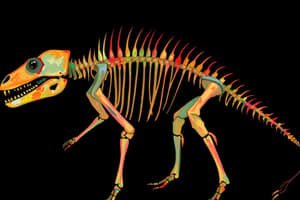Podcast
Questions and Answers
Which phylum contains all living vertebrates?
Which phylum contains all living vertebrates?
- Chordata (correct)
- Arthropoda
- Annelida
- Mollusca
What marine animal lacks a backbone during its entire life cycle?
What marine animal lacks a backbone during its entire life cycle?
- Acorn worm
- Hagfish
- Sea squirt (correct)
- Lamprey
Which class of vertebrates includes sea squirts?
Which class of vertebrates includes sea squirts?
- Urochordata (correct)
- Chondrichthyes
- Agnatha
- Cephalochordata
What structure makes cephalochordates particularly interesting for studying regeneration?
What structure makes cephalochordates particularly interesting for studying regeneration?
Which class do acorn worms belong to?
Which class do acorn worms belong to?
What is the primary component of the skeletons of Chondrichthyes?
What is the primary component of the skeletons of Chondrichthyes?
What do members of the class Osteichthyes use to support their fins?
What do members of the class Osteichthyes use to support their fins?
Which group lays eggs outside of water?
Which group lays eggs outside of water?
What is a notable evolutionary trait of amniotes compared to aquatic species?
What is a notable evolutionary trait of amniotes compared to aquatic species?
Why is understanding vertebrate classification important according to the text?
Why is understanding vertebrate classification important according to the text?
Study Notes
Understanding Vertebrate Zoology: A Comprehensive Look at All Vertebrates
Overview
Vertebrate zoology, also known as vertebrate biology or comparative vertebrate anatomy, is the scientific discipline that focuses on the study of animals possessing a backbone, commonly referred to as vertebrates. This field encompasses the exploration of their physiology, ecology, evolution, and diversity. By examining different aspects of vertebrates, researchers gain insights into the development of various species and the processes that shape the animal kingdom today.
Classification of Vertebrates
There are five classes within the phylum Chordata, which contains all living vertebrates:
- Urochordata: These marine animals, such as sea squirts, lack a backbone during their entire life cycle. They are typically tiny, flat, and disc-shaped creatures found attached to rocks or other hard surfaces.
- Cephalochordata: Also known as acorn worms, these marine animals share some characteristics with urochordates but exhibit a primitive version of the neural tube and other structures associated with vertebrates. Some species of cephalochordates can regrow amputated body parts, which makes them particularly interesting for scientists studying regeneration.
- Tunicata: Sea squirts belong to this class, which includes ascidians and pyrosomes. While tunicates are now generally classified as vertebrates, they differ significantly in several aspects from other vertebrates.
- Chondrichthyes: This diverse class comprises cartilaginous fish like sharks, rays, skates, and chimaeras. Characterized by their skeletons composed primarily of cartilage, these creatures exhibit various adaptations for swimming and hunting their prey.
- Osteichthyes: More commonly known as bony fish, vertebrates belonging to this class possess scales made of bone instead of teeth or mucus. Their fins are supported by bones, which allows for greater maneuverability and speed.
- Amniota: This diverse and varied group includes reptiles, birds, and mammals. Amniotes lay eggs outside of water, which provides them with additional protection against desiccation. Unlike their aquatic counterparts, amniotes evolved complex behaviors, such as thermoregulation and parental care.
Understanding the classification of vertebrates is crucial for appreciating the evolutionary relationships between species. It helps researchers understand how different traits develop and adapt over time, leading to a better understanding of the world around us.
Studying That Suits You
Use AI to generate personalized quizzes and flashcards to suit your learning preferences.
Description
Explore the classification of vertebrates within the phylum Chordata, including Urochordata, Cephalochordata, Tunicata, Chondrichthyes, Osteichthyes, and Amniota. Learn about the characteristics and diversity of each class, providing insights into the evolutionary relationships between different species.




